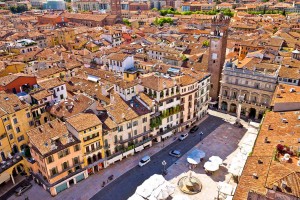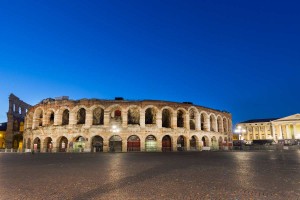
©Bigstock.com/xbrchx
When Verona’s city centre was declared UNESCO World Heritage Site in the year 2000, many probably thought only one thing: Finally! In all reality, the medieval city centre with Roman roots of this fascinating metropolis founded in pre-Christian times is among the most beautiful of its kind in all of Italy. Impressive monuments slickly combining several art and architectural eras await you around the ensemble centrepiece of Piazza delle Erbe and Piazza dei Signori. Find out here which sights are absolute must-sees and what Verona’s city centre has to do with the Scaliger.
A brief history of Verona
In order to fully enjoy the architectural diversity of Verona, it’s worth looking at the city’s history. It was founded as early as the 1st century BC by the Euganei and Raetians, then conquered by the Cenomani – an ancient tribe of the Cisalpine Gauls – and eventually absorbed into the Roman Empire in 89 BC. The colony blossomed during Augustus’ reign turning into a major city before Attila’s ravages and the takeovers by the Ostrogoths and the Lombards caused devastating destructions.
The city’s highly eventful history with different rulers and brutal power struggles extended into the Middle Ages, even into the Renaissance. Among those laying claim to Verona were the Bavarians, the Milanese and the Venetians before it was eventually incorporated into the Kingdom of Italy in 1866 after the Austro-Prussian War. The Scaliger proved to be a gleam of hope during these turbulent centuries, at least in terms of art and architectural history. Their reign, which lasted through most of the 13th and the 14th century, saw numerous military dispute and schemes as well. Still, together with the subsequent administration of the Republic of Venice, they caused a genuine construction boom period. Their ideas, endeavours and construction initiatives continue to dominate Verona’s cityscape to this very day.
The heart of the city centre
The actual core of Verona’s city centre are the remains of the original Roman settlement that, to this day, are still wonderfully preserved. After the medieval reconstruction and the extension of the city walls by the Scaliger, two squares became the centre of attention. They still form the heart of the city and let all of Verona’s architectural eras clash with one another.
Piazza delle Erbe was originally home of the forum, the Roman centre of trade. There’s still a gloriously scenic fruit and vegetable market for you to experience here. Framed by historic, imposing facades, you will be enchanted by the fine smells – you can probably feel your mouth watering just thinking about it! Additionally, we recommend sneaking a peek or two inside the various 14th century palaces, such as Palazzi Case Mazzanti with its painted facades or the grand Palazzo Casa dei Mercanti. There’s also a picturesque fountain with a statue from Roman times at the heart of the square.
Cross Piazza delle Erbe to reach Piazza dei Signori. The portico of Loggia del Consiglio was the site of Verona’s political life in the 16th century. Back then, the piazza was also home of both the military and the administrative power in Palazzo di Cansignorio and Palazzo del Comune. However, without a shadow of doubt, the eyecatcher of the square is Torre dei Lamberti. Originally built as a communal tower in the 12th century, you get to enjoy the breathtaking view across the entire city from the observation deck at dizzying heights. If the 368 steps to the stop are too tiring for you, you can certainly take the lift.
Roman Verona

©Bigstock.com/gar1984
The city centre is home to some of the best-preserved and most extensive relic collections of Roman monuments in all of Italy. Here are some of our favourites:
- Arena: In Roman times this site of gory gladiator combat held over 30,000 spectators. An earthquake in 1117 destroyed most of the outer ring, which was henceforth used as the city quarry. Still, the Arena managed to retain its original charm and has since become a popular venue, particularly in summer, of operas and pop/rock concerts.
- Theatre: Teatro Romano used to be a genuinely splendid building, adorned ostentatiously and situated at the Adige shore. Left to deteriorate in later years, the facility, which was renovated diligently in the 19th century, is now one of the city’s most popular tourist attractions. You can find many other fascinating ruins and an archaeological museum in the former Jesuati abbey in direct proximity.
- Gavi Arch: When Napoleon’s troops occupied Verona in 1805, the general had the Arco di Gavi at Via Postumia, built in the 1st century AD, torn down as he considered it a military obstacle. It took almost 130 years until the arch was finally rebuilt in a small park between the river Adige and Corso Cavour.
- Ponte Pietra: Rebuilt in parts over the course of centuries, most of this Roman arch bridge across the Adige indeed dates back to its origin around 100 BC. Five striking arches now connect Roman elements with components from the times of the Scaliger and the Republic of Venice.
Other highlights in Verona’s city centre
Both the Scaliger and the Venetians also left their marks on the particularly multifaceted and stunning cityscape of Verona. It is absolutely impossible to list all sights, but you most certainly should visit the following highlights:
- Castelvecchio: Cangrande II della Scala had this quadrangular castle, connected to neighbouring Scaliger estate by the bridge Ponte Scaligero, built in mid-14th Later rulers executed various changes to the building before it was declared a museum in 1923. The diversity of Verona’s painting school will certainly impress you!
- Ponte Scaligero: This medieval escape path from the Scaliger castle Castelvecchio stands for incredible sturdiness and survived several brutal floods. Destroyed multiple times by enemy troops, the bridge was reconstructed true to original except for the left tower.
- San Zeno Maggiore: One of Verona’s most beautiful sacral buildings dates back to the 11th and 12th Romanesque and Gothic elements clash almost artistically. San Zeno Maggiore is a “best of” of Verona architecture of sorts ranging from the playful colour scheme to the lovely rose window to the high-rising campanile.
- Cathedral: Originally home to villas in Roman times, constructions of the first basilica began as early as the 4th Destroyed multiple times by fires and earthquakes, the Cathedral received its present look in the late 15th century. Get to experience fantastic art treasures from frescoes to Titian’s altarpiece to Nicolò’s porch.
- Scaliger cemetery: Shortly after having risen to power in mid-13th century the Scaliger declared the Romanesque Santa Maria Antica their church. See the pompous last resting place of the former rulers on the large cemetery. Ostentatiously adorned sarcophagi, statues and tombs recall likely the most enigmatic rulers of Verona.
We could go on like this forever as Verona’s city centre is everything but poor in highlights. Where to start? Where to begin? Best spend several days in this stunning city and be enchanted the different eras and architectural styles. ZAINOO wishes you lots of fun in this glorious UNESCO World Heritage Site!